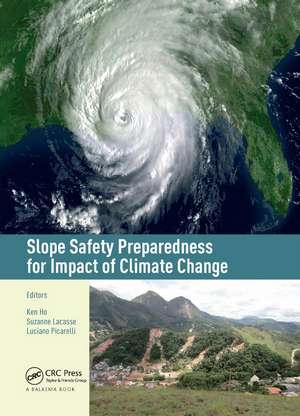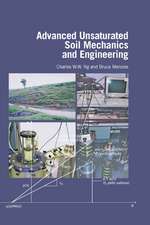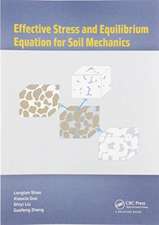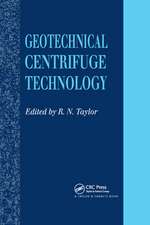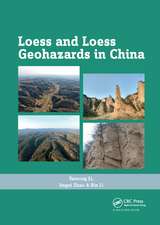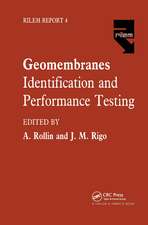Slope Safety Preparedness for Impact of Climate Change
Editat de Ken Ho, Suzanne Lacasse, Luciano Picarellien Limba Engleză Paperback – 12 dec 2019
This book helps to fill in the gap due to the fact that landslide hazards are commonly not covered under the policy debate on climate change. The book highlights the importance of raising awareness to the challenges of landslide hazards due to climate impact. It provides a holistic frame for understanding the key issues and new tools that could be used to assess and manage the landslide risks.
The book gathers contributions from 21 countries and regions in the form of national reports or summaries with respect to four key aspects: a) the methods used for evaluating changing weather and changing landslide patterns; b) the changing weather patterns; c) the changing landslide patterns and hazard scenarios; d) the applications to risk management and the formulation of adaptation measures.
Recommendations are made for enhanced preparedness and resilience. Improved crisis management and areas for future work are suggested.
Preț: 439.88 lei
Preț vechi: 559.41 lei
-21% Nou
Puncte Express: 660
Preț estimativ în valută:
84.18€ • 91.41$ • 70.71£
84.18€ • 91.41$ • 70.71£
Carte tipărită la comandă
Livrare economică 23 aprilie-07 mai
Preluare comenzi: 021 569.72.76
Specificații
ISBN-13: 9780367885533
ISBN-10: 0367885530
Pagini: 590
Dimensiuni: 174 x 246 x 38 mm
Greutate: 1.1 kg
Ediția:1
Editura: CRC Press
Colecția CRC Press
ISBN-10: 0367885530
Pagini: 590
Dimensiuni: 174 x 246 x 38 mm
Greutate: 1.1 kg
Ediția:1
Editura: CRC Press
Colecția CRC Press
Public țintă
Professional Practice & DevelopmentCuprins
1. Preparedness for Climate Change Impact on Slope Safety.
Country / Regional Reports
2. Technical report on landslide related disasters in Brazil
3. Potential Impacts of Climate Change on Landslides Occurrence in Canada
4. Enhancing slope safety preparedness for extreme rainfall and potential climate change impacts in Hong Kong
5. Potential climate changes in Italy and consequences on land stability
6. Global warming and landslide disaster: evidences from Japan
7. Landslide risk management in Norway
8. Overview of landslides distribution in Russian Federation and variations of their activity due to climate change
9. Slope Safety Preparedness in Southeast Asia for Effects of Climate Change
10. Review of landslide occurrence in Spain and its relation to climate.
11. TR3 Project: Slope Safety Preparedness for Effects of Climate Change Contribution for Switzerland
12. Review of Landslide occurrence and climate change in Taiwan
13. Landslides and climate change in the United Kingdom
14. Landslide hazards and climate change: a perspective from the United States.
Country / Regional Reports
2. Technical report on landslide related disasters in Brazil
3. Potential Impacts of Climate Change on Landslides Occurrence in Canada
4. Enhancing slope safety preparedness for extreme rainfall and potential climate change impacts in Hong Kong
5. Potential climate changes in Italy and consequences on land stability
6. Global warming and landslide disaster: evidences from Japan
7. Landslide risk management in Norway
8. Overview of landslides distribution in Russian Federation and variations of their activity due to climate change
9. Slope Safety Preparedness in Southeast Asia for Effects of Climate Change
10. Review of landslide occurrence in Spain and its relation to climate.
11. TR3 Project: Slope Safety Preparedness for Effects of Climate Change Contribution for Switzerland
12. Review of Landslide occurrence and climate change in Taiwan
13. Landslides and climate change in the United Kingdom
14. Landslide hazards and climate change: a perspective from the United States.
Notă biografică
Mr. Ken Ho obtained his BSc in civil engineering and his MSc in soil mechanics and engineering seismology, both from Imperial College London. He is currently the Deputy Head of the Geotechnical Engineering Office of the Hong Kong Government and an Adjunct Professor at the University of Hong Kong. He is also a core member of Joint Technical Committee JTC1 on Landslides under the auspices of the Federation of International Geo-engineering Societies (FedIGS) on Natural Slopes and Landslides, and has previously served as a core member of ISSMGE Technical Committee TC304 on Engineering Practice in Risk Assessment and Management. Ken has published over 100 papers on slope engineering, quantified risk assessment, earthquake, piling and deep excavations. He has presented a number of keynote papers and state-of-the-art papers at various international conferences. He is also the editor of several international conference proceedings and serves on the editorial boards of a number of geotechnical journals.
Dr. Suzanne Lacasse was educated in Civil Engineering at Ecole Polytechnique of Montréal and MIT. She was Managing Director of the Norwegian Geotechnical Institute (NGI) from 1991 to 2011, and now acts as Technical Director at NGI. She gave the 37th Terzaghi Lecture on Offshore Geotechnics in 2001 and the 55th Rankine Lecture on Hazard, Risk and Reliability in Geotechnical Practice in 2015. Dr Lacasse received PhD's Honoris Causa from the University of Dundee and from the Norwegian University of Science and Technology. She is a member of the National Academy of Engineers in the USA, Canada, Norway and France. She is Honorary Professor at Zhejiang University in Hangzhou, and Chair of the Slope Safety Technical Review Board in Hong Kong. She has given keynote lectures in over 30 countries, and is the author of over 300 scientific papers.
Professor Luciano Picarelli was educated in Civil Engineering at Un
Dr. Suzanne Lacasse was educated in Civil Engineering at Ecole Polytechnique of Montréal and MIT. She was Managing Director of the Norwegian Geotechnical Institute (NGI) from 1991 to 2011, and now acts as Technical Director at NGI. She gave the 37th Terzaghi Lecture on Offshore Geotechnics in 2001 and the 55th Rankine Lecture on Hazard, Risk and Reliability in Geotechnical Practice in 2015. Dr Lacasse received PhD's Honoris Causa from the University of Dundee and from the Norwegian University of Science and Technology. She is a member of the National Academy of Engineers in the USA, Canada, Norway and France. She is Honorary Professor at Zhejiang University in Hangzhou, and Chair of the Slope Safety Technical Review Board in Hong Kong. She has given keynote lectures in over 30 countries, and is the author of over 300 scientific papers.
Professor Luciano Picarelli was educated in Civil Engineering at Un
Recenzii
"It gives me great pleasure to write this note in support of this excellent volume on the topic of the impact of climate change on landslides. […] I can assure you that this book will be on my shelf as soon as it comes out."
Jean-Louis Briaud, President of FedIGS, Federation of International Geo-engineering Societies, and Distinguished Professor at Texas A&M University
"The editors of this volume compile current views from around the world about the impact of climate change on landslide frequency and strength. Organized into 14 chapters, the work specifically provides 13 reports that represent 17 worldwide regions. These reports identify the impact of climate change on rainfall and related weather patterns, slope instability and landslide risk, and engineered slope design. They examine the variations in landslide risk management and adaptation actions while noting that more research is necessary. Although the actual content in each chapter deviates somewhat from this general framework, each one is fairly thorough in its regional analysis. With an in-depth summary in chapter 1, the editors provide coherence and context to the reports by comparing and contrasting their content. The editors identify key findings and discuss the science of climate modeling and landslide prediction, the projected range of landslide frequency and magnitude, landslide risk management, and the need for more research. A substantial number of quality figures and tables support the text, and each chapter is well referenced. A thorough index is also included.
Summing Up: Recommended. Upper-division undergraduates and above; faculty and professionals."
J. B. Huffman, University of Wisconsin-Stevens Point in: Choice Connect, September 2017 issue
Jean-Louis Briaud, President of FedIGS, Federation of International Geo-engineering Societies, and Distinguished Professor at Texas A&M University
"The editors of this volume compile current views from around the world about the impact of climate change on landslide frequency and strength. Organized into 14 chapters, the work specifically provides 13 reports that represent 17 worldwide regions. These reports identify the impact of climate change on rainfall and related weather patterns, slope instability and landslide risk, and engineered slope design. They examine the variations in landslide risk management and adaptation actions while noting that more research is necessary. Although the actual content in each chapter deviates somewhat from this general framework, each one is fairly thorough in its regional analysis. With an in-depth summary in chapter 1, the editors provide coherence and context to the reports by comparing and contrasting their content. The editors identify key findings and discuss the science of climate modeling and landslide prediction, the projected range of landslide frequency and magnitude, landslide risk management, and the need for more research. A substantial number of quality figures and tables support the text, and each chapter is well referenced. A thorough index is also included.
Summing Up: Recommended. Upper-division undergraduates and above; faculty and professionals."
J. B. Huffman, University of Wisconsin-Stevens Point in: Choice Connect, September 2017 issue
Descriere
This book focuses on the potential effects of projected climate change on the stability of slopes and on landslide risk, the countermeasures required to address the new challenges, and the strategies adopted. The book is composed of 22 country/regional reports, together with an overview paper consolidating all the contributions with respect to four
